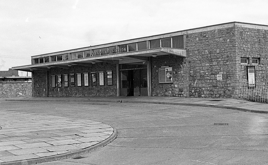“A kiss waited for driver Ray Mitchell when he piloted the 0645 Bristol-Portishead train into the north Somerset coastal town on Saturday. It was planted on his cheek by Mrs Edith Hunt.”
So wrote Geoffrey Thornton, of the Bristol Evening Post, in its September 7 1964 edition. It was Monday, the start of the first week with no rail passenger service to Portishead for almost a century.
Mrs Hunt was one of a crowd who had turned out to greet that last inward train. After a quick shunt, it departed for Bristol Temple Meads again, rammed with some 150 enthusiasts, who cheered as detonators exploded at every station along the line. A typical end to a long history, which had started with a need and finished with redundancy.
Back then, no one (one supposes) could have foreseen a time when Portishead would become a dormitory town for Bristol, with a road between the two that often failed to cope with the volume of commuter traffic.
As the 19th century matured and ships grew larger, the city centre location of Bristol harbour, coupled with the problems of negotiating the Avon Valley to reach it, placed increasing constraints on development.
At first, it seemed that the honour of expansion would fall to Portbury, with authority to build a floating pier and a railway connecting it to the city having been obtained by the Portbury Pier & Railway Company in 1846. But, as was so often the case with these schemes, funds could not be raised and the firm was soon dissolved.
Plans of varying merit continued to be put forward until, in July 1862, the Bristol Port Railway & Pier Company obtained authority for a line on the eastern side of the Avon, between Hotwells and Avonmouth. This opened in March 1865 and would later morph into the Severn Beach branch we know today.
However, those who saw more benefit in a port on the opposite side of the river pressed on, and formed another scheme for Portbury, with a branch to serve it from the Bristol & Exeter Railway (which had been open in full since 1844). Chaired by Alderman James Ford, a director of the Taff Vale Railway, the Bristol and Portishead Pier and Railway Company (BPPR) received Royal Assent in June 1863. Construction started just before Easter the following year.
Built to Brunel’s broad gauge, work continued at such pace that the first section - from junction to Rownham, near Clifton Bridge - had been completed by the early months of 1865.
A number of changes to the planned route were made as the work went on, most notably the replacement of the proposed pier at Portbury with a dock at Portishead itself. The former would have been exposed to westerly winds and would have had limited accommodation for vessels. A new Act authorising these works was approved in 1866.
Read this feature in full in RAIL issue 979 here
To read all our magazine articles, choose from either a Digital Edition Membership from just 99p for your first month, or a Print & Digital Edition package from just £9.50 per month. Choose your Membership here















Login to comment
Comments
Davina Elaine Hockin - 31/03/2023 23:03
I photographed the departure of the last train from Portishead BR Station